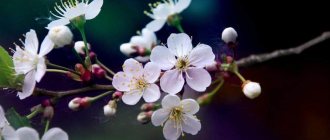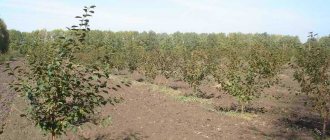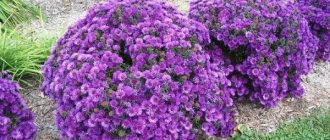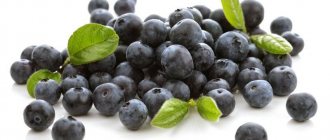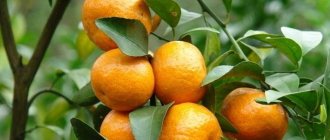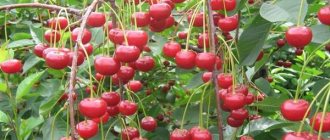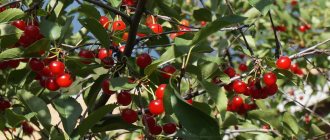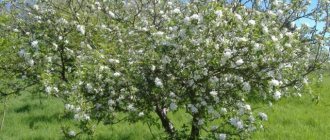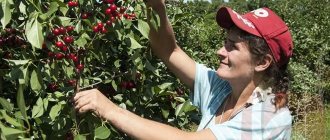The Zhukovskaya cherry variety is a representative of the “old guard” of domestic selection. Its description dates back to the 40s of the last century. Today, Zhukovskaya cherry has not lost its popularity at all. It has become a high-quality, reliable, time-tested fruit tree that can be found both in home and industrial gardens.
Cherry variety Zhukovskaya: description and characteristics, photos, reviews, pollinators, pruning, planting and care
Not all gardeners know that any varieties of cherries growing in garden plots originated from their following wild “relatives” - steppe, felt, Magaleb, common and sweet cherries.
A special place among the cultivated varieties of cherries is given to dukas - a variety of this fruit tree, descended from the crossing of cherries and sweet cherries. Dukes took the best qualities from their “parents”, including high resistance to frost.
Zhukovskaya cherry is one of the most frost-resistant among dukes
.
Other characteristics, nuances of growing, advantages and disadvantages of this cherry will be discussed below.
.
The content of the article:
1. History of the variety 2. Description and characteristics of the Zhukovskaya cherry variety 3. Zhukovskaya cherry variety - pollinating trees 4. Productivity of the variety 5. Diseases and pests 6. Advantages and disadvantages 7. Planting and growing Zhukovskaya cherry 8. Further care of the variety 9. Pruning and crown formation 10. Feeding cherries 11. Preparing for winter 12. Zhukovskaya cherry: reviews from those who grow
History of the variety
The name of the hybrid varieties “Duke” comes from the English variety May Duke - it was created by accident by randomly crossing a cherry tree with a sweet cherry back in the 17th century. This variety is still grown in some areas in the southern Russian regions.
A brief overview of Zhukovskaya cherries - video
On a note!
"Duke" is a hybrid of cherry and sweet cherry.
Ivan Michurin bred the first Russian Duke in the last quarter of the 19th century by crossing the Winkler Belaya cherry variety and the Belle cherry.
The new variety is called Beauty of the North; its main positive feature is its high resistance to frost. But the taste of the fruits of this variety was not very good, and the harvested crop did not tolerate transportation well. Because of this, the Beauty of the North cherry was not popular among gardeners.
Although it is quite simple to cross varieties of cherries and cherries with each other, new dukes appeared extremely rarely, the main reason for this being the extremely low yields of such hybrids.
Photo of Zhukovskaya cherry
The Zhukovskaya cherry variety was bred by breeders from the Michurin All-Russian Research Institute of Horticulture S.V. Zhukov and E.N. Kharitonova in 1947. The resulting cherry is recommended for growing in cold regions, since its resistance to frost is the highest among all dukes.
Cherry Zhukovskaya: description and characteristics of the variety
Judging by the characteristics, general description and taste of the fruit, it is clear that the Zhukovskaya variety is not very similar to cherries - it received most of its qualities from cherries.
This fruit tree is compact, medium in size, reaches a height of 2.4-2.6 m, but part of the main trunk grows up to 3.5 m in height. Its crown is round in shape, slightly spreading.
Photo of Zhukovskaya cherry fruit tree
The main branches extending from the trunk are curved, have medium leaves, and their thickness is average. The color of the bark is brown with a reddish tint, it is covered with lentil-shaped growths, the color of which is silver with a yellow tint. The foliage is oval, the tips are sharp, elongated. The color of the leaves is dark emerald. They are attached to the shoots using long petioles, which are attached at an acute angle to the branches. The foliage bends slightly downwards.
Large white flowers bloom on bouquet branches and can occasionally appear on annual shoots.
The shape of the fruits of the Zhukovskaya cherry is round at the base, the top is slightly elongated, they look like hearts. The sizes of ripe berries are uneven, their weight is from 4 to 7 g
.
Photo of Zhukovskaya cherry fruit size
On a note!
The taste of ripe Zhukovskaya cherries is excellent - sweet with a characteristic sourness, the pulp is tender and dense. Tasting score – 5 points.
The seeds are large, separated quite well from the pulp of ripe berries, which are firmly attached to the stalks. Even after ripening, the fruits do not fall off.
Photo of Zhukovskaya cherry seeds
The harvested crop is of universal use, the berries are eaten fresh, boiled into compotes, used for preservation: jams are prepared, jams are made, compotes are rolled up and frozen for the winter. Ripe fruits are easily torn from the stalks, tolerate long-distance transportation well, without losing their presentation and taste.
Good to know!
Even in nurseries, the Zhukovskaya variety is sold as a cherry, because almost all its characteristics are closer to these fruit trees than to cherries.
Since this fruit tree has a well-developed root system, it tolerates even long periods of drought.
With enough moisture, ripening cherries become large, sweet and juicy.
However, when caring for this fruit tree , you should follow the watering regime, since too frequent watering also negatively affects the quality of the fruits - they begin to crack, their taste deteriorates, and the berries become more watery.
Therefore, if there is little rain, then watering is carried out once every 14-16 days. GOOD CHERRY VARIETY!
Cherry Shokoladnitsa
Without problems and additional shelter, the Zhukovskaya cherry fruit tree winters in the Central Black Earth, Middle Volga and Black Earth regions.
But in more northern regions, it is recommended to add a layer of mulch up to 15 cm thick to the tree trunk circles.
It is recommended to use humus as a mulching element, which will simultaneously protect the root system from frost and also serve as a source of macro- and microelements. The standard should be wrapped in burlap, but other covering material can be used.
How to plant cherries in the ground?
Zhukovskaya is not capable of self-pollinating, so obtaining a harvest is impossible without the presence of other cherries on the site. Good choices are Vladimirskaya, Shirpotreb black, Lyubskaya, Molodezhnaya, Griot Ostgeimsky and Apukhtinskaya. It is advisable to have 3-4 trees on the site at the same time.
The best time to plant Zhukovskaya is April
The optimal time for planting Zhukovskaya is April. In warm southern regions, the procedure can be carried out in the fall, during September or in the first ten days of October.
To choose a suitable place for cherries, you need to take into account the needs of this crop:
- Absence of shade and cold drafts in the selected location.
- Sandy loam or chernozem soil with neutral acidity. Clay soils should be avoided; they are absolutely unsuitable for this crop.
- Soil that does not resemble a swamp. Cherry does not like areas with flooding, so if the groundwater in the selected location comes closer to the surface than 1.5 m, look for another option. Also not the best choice are lowlands where melt water stands for a long time in the spring.
Seedlings must meet certain quality criteria
When choosing planting material, you should pay attention to the condition of the plant:
- The seedling should not have mechanical damage, growths or ulcers on the bark. It should feel smooth and elastic to the touch, not rough and wrinkled.
- Suitable for planting are one- or two-year-old plants 1–1.2 m high with roots at least 20 cm long.
- It is recommended to buy cherries in the fall; the choice at this time is quite wide, unlike in the spring.
For the winter, the tree is buried. To do this, choose a shaded area, prepare a hole up to 30 cm deep, place the plant in an inclined position, cover the roots and part of the trunk with earth. Remove the seedling before planting.
Planting cherries is not much different from a similar procedure carried out for other fruit trees
The process of planting a tree occurs in the following sequence:
- For cherries, dig a hole 60 cm deep and 80 cm wide. This must be done in advance. If the procedure is planned for spring - at the end of autumn, when planting cherries before winter - 2-3 weeks in advance.
- The removed soil (upper 15–20 cm) is mixed with 5 kg of humus, 60 g of simple superphosphate and 40 g of potassium chloride.
- A wooden stake is placed in the center of the recess. A nutrient composition is poured into the bottom in the form of a mound, on which the plant is then placed. Be careful not to deepen the root collar in the process. It should be located 5–6 cm above the soil level.
- The seedling is carefully examined beforehand. If there are damaged or dry areas on the roots, they should be cut off.
- The plant is placed in a hole and covered with prepared soil. In this case, it is necessary to ensure that the barrel is in a vertical position.
- Then the soil around the cherry is slightly compacted. At a distance of 30 cm from the trunk, a low roller is formed and the tree is watered with two buckets of water.
- The tree trunk circle is mulched with compost or sawdust in a layer of 2–3 cm. This will prevent cracking of the soil and evaporation of moisture.
- The seedling is not tied too tightly to the support so that it has the opportunity to settle a little along with the soil.
Pollinator trees for cherries of the Zhukovskaya variety
This duke is self-sterile - if pollinating trees do not grow nearby, then only about 5% of all flowers on the Zhukovskaya cherry will be fertilized. For dukes, not all varieties of stone fruits will be successful pollinators.
And it is better to plant the following varieties of cherries (but not sweet cherries) nearby for better pollination of the Zhukovskaya cherry
:
- Lyubskaya;
- Apukhinskaya;
- Vladimirskaya;
- Youth;
- Griot Ostheimersky;
- Black consumer goods.
Useful article:
How to improve soil composition
Productivity of the Zhukovskaya cherry variety and ripening period
In the central regions of Russia, the berries of the Zhukovskaya cherry variety begin to ripen in the second decade of June; in colder regions, the fruits ripen a couple of weeks later.
Photo of Zhukovskaya cherry harvest
The first harvest from this cherry is harvested 4 years after the seedlings are planted on the site.
This fruit tree begins to produce maximum yield by the 10th season and continues to actively bear fruit for another 5-6 seasons.
Then the productivity of Zhukovskaya cherries declines. In total, the Zhukovskaya variety “lives” for about 20 years.
But fruiting in this fruit tree is unstable and directly depends on weather conditions. In cold rainy seasons, even mature Zhukovskaya trees can produce no more than 4 kg of ripe berries. And in years with favorable climatic conditions, more than 20 kg of ripe berries are collected from the same tree. With good care, an adult cherry of this variety produces 27-30 kg of harvest.
The ripening of berries is friendly.
Harvesting
Fruiting of the Zhukovskaya cherry variety occurs in the 4th year. A tree at the age of 10 years brings from 10 to 12 kg of harvest. And with an adult 20-year-old cherry, you can collect 30 kg of berries. The best fruiting is observed at the age of 15 - 16 years.
The fruits will ripen by the 20th of July. But a cold and rainy summer may slightly delay the ripening time. The berries ripen almost simultaneously. But they do not fall off the tree, which makes harvesting much easier. The separation of the fruit from the stalk is dry, this is also a plus.
Harvesting takes place in dry weather. The berries are torn off along with the cuttings. The fruits need to be sorted immediately - whole, dense berries can be set aside for storage, and crumpled ones can be sent for processing. For storage, cherries are laid out in flat containers or boxes, in a layer of up to 5 cm. At a humidity of at least 85% and a temperature of 8 - 100C, cherries can be preserved for 2 weeks. Cherries in their natural form will bring the most benefits.
Cherries will bring the greatest benefits in their natural form.
Some experts claim that if the bottom of a sterilized and wiped dry jar is lined with cherry leaves, and then each layer of berries is layered with leaves, then the cherries will be stored much longer.
The longest storage is possible if the fruits are frozen. Selected berries are washed, dried on a flat surface and placed in plastic bags. One package must contain a volume that is intended for one-time use.
Preparations made from Zhukovskaya cherries are very tasty. Marmalade, jam, jam, compote - in this form, cherries do not lose their beneficial properties throughout the year. Cherry fruits can also be dried. To do this, the berries are washed, dried and placed in an oven preheated to 500C. The dried fruits are poured into a clean container and left at room temperature for several days. Then packaged in containers with tight-fitting lids. Dried berries are also stored in a cool place in linen bags.
Cherries can not only be canned, but also dried
Diseases and pests of cherry trees
From the cherry variety Zhukovskaya has acquired high resistance to most diseases, including coccomycosis and ring spot. Zhukovskaya cherry is also rarely damaged by pests.
Scheme of protection against diseases and pests of cherries - video
However, it is still necessary to carry out preventive spraying in spring and autumn in order to protect this fruit tree from possible diseases and attacks by “harmful” bugs.
Reviews
- Alexey: “I don’t consider myself a very experienced gardener, but I approach the choice of garden varieties very seriously. When it came to cherries, the priority was taste, because cherry jam is a favorite childhood delicacy and I didn’t want to waste money and time on some sour stuff. The seller did not deceive when he recommended Zhukovskaya. The cherry grew as it should, with strong shoots and numerous berries. The first harvest was quite large (but we also bought six seedlings at once). Among other varieties, this berry stands out for its ruby color and persistent aroma. In the end, I am very pleased with the purchase, I didn’t notice any special difficulties in caring for it, I planted it and that’s it. Our winters are quite mild, so I never prepared any shelter for the seedlings. It’s better to let natural selection take place than to worry every year about whether he will survive or freeze.”
- Oksana: “The long-awaited move to a new house added a lot of hassle, including with the garden. I’m far from a fan of endless beds, so I decided to plant almost the entire plot with a garden. There is less hassle with trees, and you can buy potatoes at the market. We planted cherries almost first (our whole family loves this berry), we chose several varieties with different ripening periods in order to extend the summer as long as possible. Everyone liked the “Zhukovskaya” variety: it’s a very tasty jam, and when fresh it’s very sweet and juicy.”
Advantages and disadvantages of the variety
The main advantages of Zhukovskaya cherries include:
- excellent taste, which is confirmed by the highest tasting score of 5 points;
- good presentation of the fruit;
- excellent cherry productivity;
- uniform ripening of fruits, which allows harvesting by mechanization;
- high resistance of the fruit tree to coccomycosis and ring spot;
- after ripening, Zhukovskaya berries continue to hold tightly to the stalks without falling off;
- the harvested crop can easily be transported over any distance;
- universal purpose of fruits.
But this cherry also has negative qualities:
- resistance to frost is average, therefore, without shelter, Zhukovskaya cherry can only winter in the central regions;
- in frosty winters, flower buds may freeze;
- since the Zhukovskaya tree is self-sterile, it needs pollinators;
- the seeds are large;
- Fruiting is unstable and directly depends on weather conditions.
Choosing currant varieties!
Black currant Lazy Currant Vigorous Currant Dobrynya
Cherry Zhukovskaya: planting and growing
Experts strongly recommend planting seedlings of Duke Zhukovskaya only in the spring, before sap flow begins, so that during the summer the trees have time to acclimatize and take root.
And for the northern regions, spring is the only possible time for planting Zhukovskaya cherries, because in the fall this cultivated plant does not have time to take root sufficiently and, most likely, will freeze out during the cold winter.
Choosing a location and proper planting of cherries - video
In warm regions, it is better to plant this cherry variety in the fall, after the leaves have fallen.
You should carefully consider the choice of site for planting seedlings of this cherry.
It must meet the following requirements
:
- the groundwater level should not be closer to the ground surface than 1.5 m;
- the site should be located on a hill and well lit by the sun. It is best to land on western, southwestern or
- northwestern slopes;
- the soil on the site should be loose and fertile, and its reaction should be neutral. Lime is added to acidified soils in the fall, and
- alumina is improved using river sand;
- Humus or compost must be added to the planting holes, as well as fertilizers containing potassium and phosphorus.
BLUEBERRY!
Blueberry Bluecrop
Note!
If Zhukovskaya cherry seedlings are discharged from the nursery, they are usually delivered with a closed root system. Such trees do not have their root system disturbed during transportation; they acclimatize faster in a new location.
Photo of cherry planting scheme
Before planting, pour at least one bucket of water into the holes, wait until it is absorbed, and only then can the trees be planted. The seedlings are placed in the prepared planting hole along with a lump of earth. A stake is driven into the hole, to which the tree is tied - in this case, it will take root better and will not bend to the sides after watering or gusts of strong wind.
Then the holes are filled with a nutrient substrate that needs to be compacted, and watering is done again.
Features of cultivation
Zhukovskaya cherry does not differ in special approaches when planting and growing. It is enough to follow a few simple rules of agricultural technology for this crop in order to eventually get a beautiful and productive tree.
Boarding time
According to the description, Zhukovskaya cherries are not very resistant to frost. Therefore, it is best to plant it in the spring. When planted in autumn, the tree may not have time to take root, and then it will not be able to survive the winter.
The most favorable month for planting cherries is April. At this time, the earth is already sufficiently warmed up, but the plants are just beginning to wake up.
Selection of planting material
It is best to grow Zhukovskaya cherries from seedlings purchased from a special nursery. In this case, the buyer will have guarantees that he purchased the right variety.
Planting material must correspond to the climate zone where it will be grown.
It is better to buy seedlings in the fall, since nurseries at this time of year offer a larger selection of fruit trees. In this case, the seedling can be preserved until spring in the cellar, or by burying it in the ground at an angle of 45°.
When choosing a seedling, it is necessary that it meets the following parameters:
- age – 1-2 years;
- height – 1-1.3 m;
- root system length – 20-25 cm;
- the roots are elastic, without damage or traces of rot;
- absence of peeling, cracks, wrinkled areas and ulcers on the bark.
Selection of site and soil
Cherry variety Zhukovskaya is a heat-loving plant. For it, you need to choose a sunny area, protected from cold northern winds. The tree does not like excess moisture, so a place with shallow groundwater (less than 1.5-2 m) is not suitable for it.
Zhukovskaya should be cultivated on chernozems or sandy loam soils. It requires fertile, well-drained soil. It is not recommended to choose clay areas for this plant.
Cherry loves soil with neutral acidity, so acidic soils must be deacidified with dolomite flour or lime.
Landing
Planting Zhukovskaya cherries in the ground does not differ from the same procedure for other varieties of cherry trees. The planting hole must be prepared in advance - in the fall for spring planting, and 2-3 weeks in advance if the work is planned for the fall.
The process of planting a seedling step by step is as follows:
- Dig a hole 50-60 cm deep and 80 cm in diameter.
- A 3-5 cm drainage layer of crushed stone or broken brick is laid at the bottom of the pit.
- Install a support (wooden peg or metal rod).
- The soil is made from the top fertile layer and fertilizers in the proportion: 1 part humus or compost to 2 parts soil. Add ready-made complex mineral fertilizers at the rate of 400 g (or 3 liters of wood ash) per pit. If planting is carried out on loam, then an additional bucket of sand is added.
- The soil is poured into the hole, covered with a waterproof cloth and left alone.
- Immediately before planting (several hours), the roots of the seedling are placed in a solution of a growth stimulator, either simply in water, or in a manure-clay mash. All dry and questionable quality roots must be cut off.
- A hole is dug and a seedling is placed in it.
- The roots are carefully straightened in different directions and begin to be buried in soil, lightly pressing down.
- The standard is tied to a support.
- The seedling is buried up to the root collar, which should be above the ground.
- A tree trunk circle with a roller is formed (in the winter the roller will need to be removed so that water does not stagnate near the trunk).
- The tree is watered with 2 buckets of water, adding them in portions, so as not to create a swamp at the roots.
- The tree trunk circle is mulched with peat, grass or compost.
- The final stage of planting is pruning. 4-5 main strong branches are left on the seedling, which look in different directions, and they are shortened by a third. The central conductor is also cut so that there is a distance of 10-15 cm between it and the last shoot.
Further care for the Zhukovskaya cherry variety
Further care consists of regular watering, loosening the tree trunks while removing weeds, fertilizing, pruning and preparing trees for the winter.
Zhukovskaya cherry requires regular watering in hot and dry summers, but you shouldn’t overwater it.
The soil in the tree trunk circles should be constantly moist. Typically, up to 20 liters of water are added for each young tree planted.
Photo of watering a Zhukovskaya cherry seedling
After the Zhukovskaya cherry has taken root, the amount of watering is reduced.
In hot weather, this cherry is watered once every 14-16 days. If the weather is rainy, then additional watering should not be done. After each watering, it is necessary to loosen the tree trunk circle.
Before harvesting ripe berries (about 12-14 days in advance), watering is stopped.
Care
Caring for cherries involves timely application of fertilizing, pruning, and treatment against pests and diseases. These measures will allow you to grow a healthy and strong plant with a high level of fruiting.
How to care for the hole?
The surrounding area must be kept clean, especially in the first years after planting. Near young plants, weeds are removed manually or by mowing. Pesticides can be sprayed near mature, mature trees.
Watering
It is necessary to water cherries at least once a week during the growing season. During the fruiting period, from June to July, the soil should be moistened in the morning and evening at the rate of 15 liters per tree. Stop watering in August.
Important! If you continue to water the tree, you can provoke protracted growth of shoots and reduce winter hardiness.
Trimming
It is recommended to prune cherry trees in the spring, in March or April, or in the fall, after leaf fall.
The first pruning is carried out at planting. The seedling is shortened by one third. The skeleton of a young tree is formed from 6-8 main branches, which are arranged in tiers at the same distance. The height of the stem is 40 cm.
If the skeletal branches of the seedling are thin and long, you need to cut them by 15-20 cm, and in any case they should be lower than the central conductor
In an annual plant, young shoots 20-40 cm long are not cut off, but if the length exceeds 50 cm, they should be shortened by 1/3. Remove root shoots, damaged and broken branches.
Crown formation begins at the age of five. Skeletal branches are shortened at the point where the growth of lateral branches stops. New shoots that stretch upward and thicken the crown are cut off at the point where they depart from the main branch. The trunk is shortened at the level of 3-3.5 m.
Autumn pruning is preventive in nature. At this time, dry and damaged branches are removed, which are then burned.
Rejuvenating pruning of mature trees is carried out if the growth of branches is less than 15 cm per year. In this case, the skeletal branches are shortened by 1/3. The frequency of pruning cherry trees is once every 3 years.
A large number of simultaneously removed branches can provoke gum production, so anti-aging pruning is carried out in several stages.
Wounds formed during the process of pruning branches are treated with garden varnish or its analogues.
Pruning a cherry tree (video)
Preparing for winter
Cherry Zhukovskaya is a variety of medium frost resistance. To prevent damage to a young tree, the tree trunk circle is mulched with rotted manure or a thick layer of wood shavings.
The standard is wrapped with a special covering material or paper.
Important! It is recommended to wrap an annual tree completely.
Cherries are covered for the winter at the end of October. However, this can be done even when the first snow appears. Depending on the weather, the timing of shelter may vary.
The stem and bases of skeletal branches are wrapped in light paper or newspapers in 2-3 layers
When preparing cherry trees for winter, autumn watering is very important. This is done after the leaves have fallen. Each adult tree needs up to 15 liters of water, and 7-8 liters will be enough for young cherries. Abundant watering will help the plant to overwinter well.
Other important care details
- In the first year, during the flowering period, it is recommended to remove all flowers, and in the second year - 70% of the flowers.
- On plants 4-5 years old, ovaries are rationed.
- The tree is prone to overgrowth. It must be removed regularly.
- For better oxygen saturation, the soil in the circle around the trunk is periodically loosened.
Top dressing
The first time cherries are fed 2-3 years after planting. To enrich the plant, mineral and organic mixtures and solutions are used. Depending on the season and period, the required type of fertilizer is selected.
| Season | Type of feeding | Period | Preparations and proportions |
| Spring | root | during flowering |
|
| after flowering | Nitroammophoska solution. Prepare in a ratio of 1:200. One tree requires 3 buckets of solution. | ||
| Summer | foliar | June 15-30 | Solutions containing potassium and phosphorus. Ammophos, 2% solution of magnesium sulfate, nitroammophos. Prepare according to instructions. |
| Autumn | root | end of September |
|
Important! Spring and autumn fertilizing is mandatory. It is better to apply nitrogen-containing fertilizers in the autumn, and potassium and phosphorus fertilizers in the spring.
Proper feeding of cherries is the key to excellent tree development and a high-quality harvest.
Protection from diseases and pests
Zhukovskaya cherry is quite often exposed to various diseases and pest attacks. The most dangerous are:
- scab;
- brown spot;
- fruit moth;
- cherry leaf roller;
- moth.
The best results in the fight against them are obtained by chemical treatment with appropriate pesticides and fungicides.
Preparations for protecting cherries from pests (table)
| Period | A drug |
| Before flowering |
|
| After flowering |
|
| Growing season |
|
| Prevention |
|
How to protect cherries from diseases (table)
| Period | A drug |
| Before the buds open |
|
| During bud break |
|
| After flowering |
|
| Two weeks after flowering | urea solution 5% |
| During fruit growth |
|
Important! The last chemical treatment of the tree is carried out 30-35 days before harvest.
All solutions are prepared according to the instructions. The processing frequency is 7-15 days.
Cherry Zhukovskaya: preparing for winter
After the leaves have fallen, the cherry tree needs to be prepared for the winter. First of all, water-charging irrigation is carried out, adding at least 20-25 liters of water under each tree. Then organic and mineral fertilizers are applied (for autumn digging).
Then a layer of mulch at least 15 cm thick is added to the tree trunk circles to protect the root system from frost.
Humus is usually used as mulch. The standard is wrapped in burlap or other covering material. It is better to cover young trees completely for the winter.
Photo of Zhukovskaya cherry trunk wrapping
Unfortunately, it is impossible to completely cover mature trees for the winter, so some of their flower buds still freeze in the winter.
Need to know!
The Zhukovskaya cherry trees planted this season completely cover everything.
There are no specific terms for covering this variety of cherries - it all depends on the weather conditions in the planting region. Experts recommend waiting until frost begins, and only then covering the cherries for the winter.
How and when to plant
When purchasing a seedling, the first thing to do is to make sure of its viability. The roots should be flexible and light when cut. There should be no damage or rotting places on the trunk and branches. Many gardeners practice soaking seedlings in a root stimulant solution, but you can simply use warm water. This video will help you understand how the Shokoladnitsa cherry is planted in the spring, and what are the features of its cultivation.
It is advisable to plant in open ground as early as possible to prevent the rhizomes from drying out.
Landing algorithm:
- The place should be sunny, protected from drafts and at a sufficient distance from other trees and buildings.
- It is necessary to add a bucket of humus to the soil for each square meter, coarse sand (0.5 buckets) and mineral fertilizers (preferably potassium and phosphorus, but it is better not to use nitrogen). The soil at the site of future plantings must be dug well and allowed to stand for at least a couple of days.
- Before planting, the seedling is straightened out the lateral shoots of the roots, and then deepened into the soil to the height of the root collar growth.
- The root area must be mulched to prevent the growth of weeds and drying out of the soil.
- After planting, the seedling must be watered well, and for proper formation of the trunk, it must be tied to a wooden peg driven into the ground nearby. The distance to the peg should not interfere with the normal growth of the tree.
Kalanchoe flower care at home, medicinal properties of a home doctor, Kalandiva varieties and types, photos and names
Maybe
